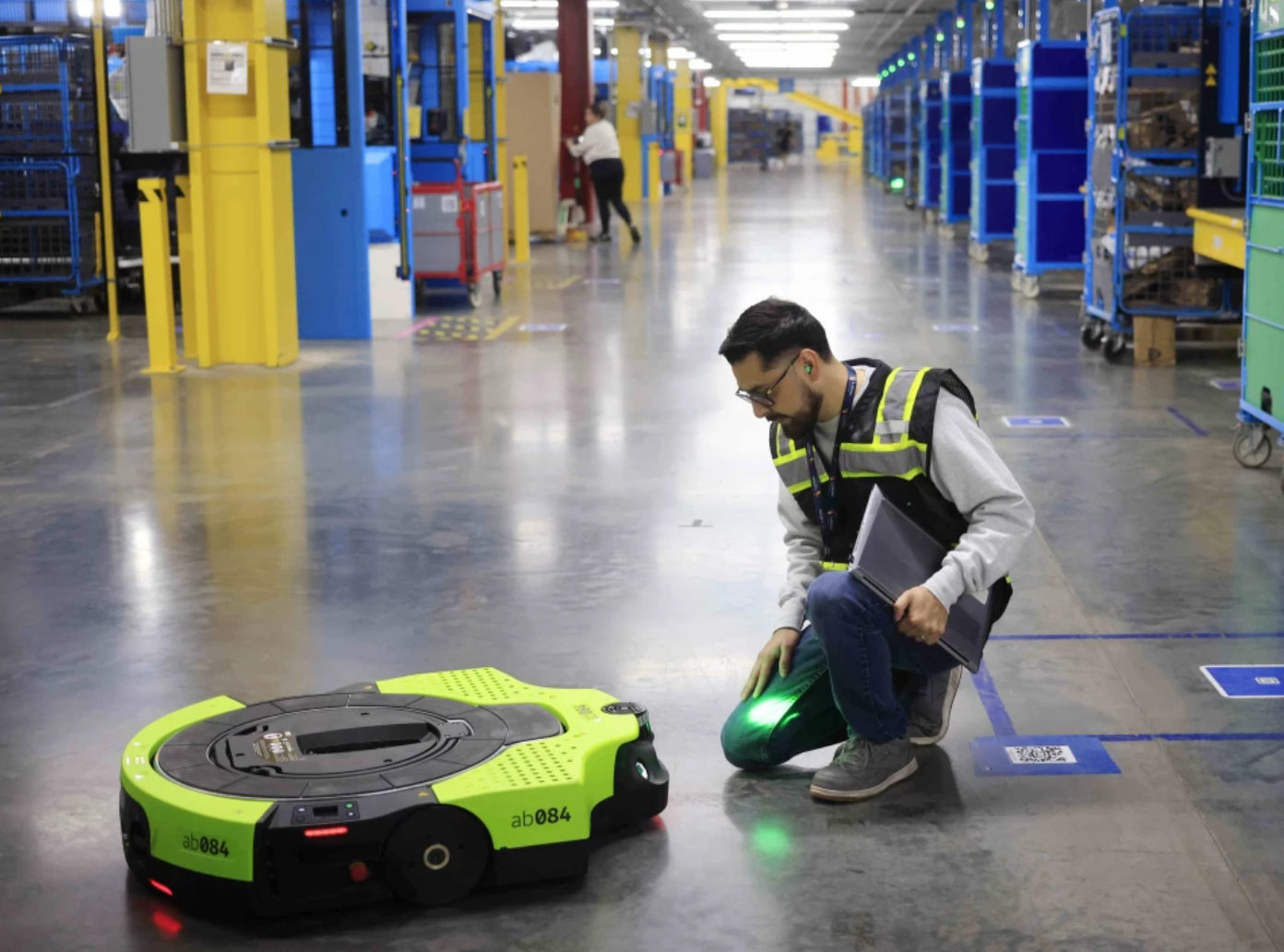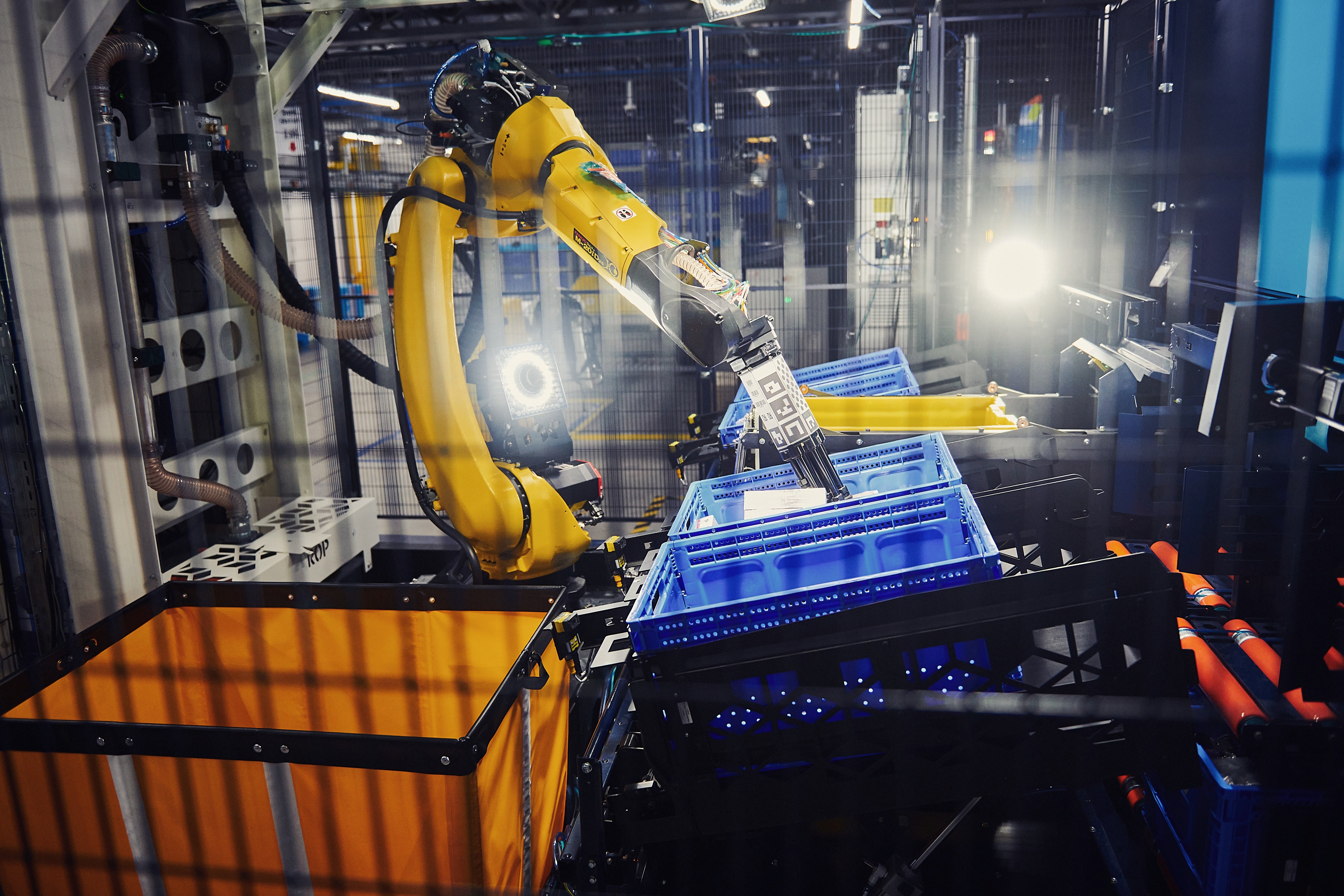How Amazon is trying to make the world fall in love with its robots
The retail giant’s autonomous robots have been precisely designed to avoid annoying or terrifying their human colleagues – but will the world welcome them, asks Andrew Griffin


Amazon’s first fully autonomous robot, Proteus, has a lot of responsibilities. Its main job is to pick up trolleys full of parcels and get them where they need to be. But it is also carries a whole other aim: to make robots into something we love.
When Amazon announced last week that it would be launching a new “next-generation” facility in Shreveport, Louisiana, it said that would come with a tenfold increase in the amount of robotics used. That in turn should make it cheaper for Amazon to ship: the company says its new warehouse has already seen the cost of getting a parcel to its destination fall by 25 per cent.
Much of that is down to Proteus, the small green machine shaped like a large Roomba and currently careening around various Amazon facilities. It is notable in part because it is the first robot to escape its confines at Amazon, and work autonomously.
In a blog post published last week, in which Amazon voices the Proteus robot, it said that the “first autonomous mobile robot” title is a “fancy way of saying, I’ve got the smarts and technology that allow me to work independently and safely around people.
“This means that I can navigate freely within my work area in our fulfillment centers and detect and avoid objects around me, allowing me to safely work outside the fenced areas where many of my robotic co-workers must stay.”
Proteus and its wider deployment marks a major breakthrough for Amazon, which is already the largest manufacturer of industrial robotics. But it will also attempt to humanise the robots, to ensure that Amazon workers are happy with them driving around their feet.
That is part of the mission to “make Proteus lovable”, according to Julie Mitchell, a director at Amazon Robotics, who helped bring the machine to life. Making it so was one of the key guiding principles behind the development of the machine, she says.
“That was our whole idea,” she said last week at Amazon’s Delivering the Future event, during which it revealed its plans to bring new technology to the logistics that get a package from the seller to your house. “We wanted to make Proteus lovable.”
That includes putting a face and eyes onto the robot, and noises that come out of it as it moves around and clears its way. It all helps safety by ensuring that human employees are aware of the robot – but it also helps humanise them too.
“The faces, the eyes that we put on it, the noises that it makes – it all purposely designed to make it lovable.”
Amazon’s robotics work has generated an awful lot of feelings in recent years, though love wouldn’t be high on the list.
For the company, they are a way of automating the repetitive tasks that have been and still currently are sometimes done by employees. Amazon says that many of those jobs are tiring and potentially even damaging to the people who do them, and that it would be better for robots to help those people out. It lays out a vision of robots not replacing but assisting humans, so that they work better together.
For critics, which include the unions, the robots are a way of automating away important jobs so that humans don’t need to be paid to do them. Even when they are not taking jobs, some have argued that having caged robots speeding around can prove stressful.
Existing Amazon robots are not lovable. While Proteus runs free, the rest are inside cages: some larger and some much smaller. They wield incredible force and speed that makes them efficient but also machinelike.

But Proteus attempts to change that in part by its design, including those eyes. As they buzz around beneath the feet of staff, they are engaged in a near-constant blinking and beeping that has been precisely refined to avoid them annoying their human colleagues.
“We put a lot of intention into the human robot interface and making that collaboration very intuitive and enjoyable. And it's worked really well,” said Miller.
“We actually used a lot of the feedback from our teams here,” she said, pointing at the large Nashville fulfillment centre behind her, which took an initial five units to test how they were received. “We learned about what made it a fun engagement, and built that back into the design. So you'll notice things like the eyes will produce, will tell you where it's planning to go based on the signals it's giving you – it'll shift its eyes to move. And so the trust and the collaboration has been kind of there since day one, since introducing this robot.”
Many questions have however focused on how Amazon plans to integrate the robots into their workforce economically, rather than practically. The company doesn’t disclose how much each robot costs or at what point they become cheaper than using humans – but it remains unclear what all of those questions mean for the jobs of the people they are zipping around in the warehouse behind Miller.
To help answer those questions, Amazon commissioned MIT’s Industrial Performance Center to investigate employees’ relationships with those robots. And the results were surprising: those doing the repetitive kind of jobs that Amazon hopes to automate away were actually relatively excited about their introduction.
“I was surprised that workers were so optimistic about the impact of automation on their job security, particularly these workers who do a lot of routine tasks but do a lot of problem solving as well,” said Ben Armstrong, executive director of MIT’s Industrial Performance Center. He and his team have published a paper that suggests that employees’ views of robots might be more nuanced than the fear and hatred that is often attributed to them.
“Common narratives about automation often pit new technologies against workers,” the team’s summary reads. “The introduction of advanced machine tools, industrial robots, and AI have all been met with concern that technological progress will mean fewer jobs. However, workers themselves offer a more optimistic, nuanced perspective.”
It found that workers doing repetitive tasks were likely to feel positively about the introduction of AI, and that what really made the difference was whether they were being asked to solve problems, and felt like they were valued by their company.
Amazon has been using robotics for years. It officially launched Amazon Robotics in 2015, but that was really a rebranding of Kiva Systems, a company it had bought three years earlier and which originally began in 2003.
And other companies are working hard on their own solutions. Elon Musk’s Tesla has repeatedly made claims about its Optimus robot, which it says will eventually be able to autonomously fulfil a range of tasks.
The technology is still a long way off. But the economic, practical and philosophical questions are already here: what does a world we share with robots look like?






Join our commenting forum
Join thought-provoking conversations, follow other Independent readers and see their replies
Comments